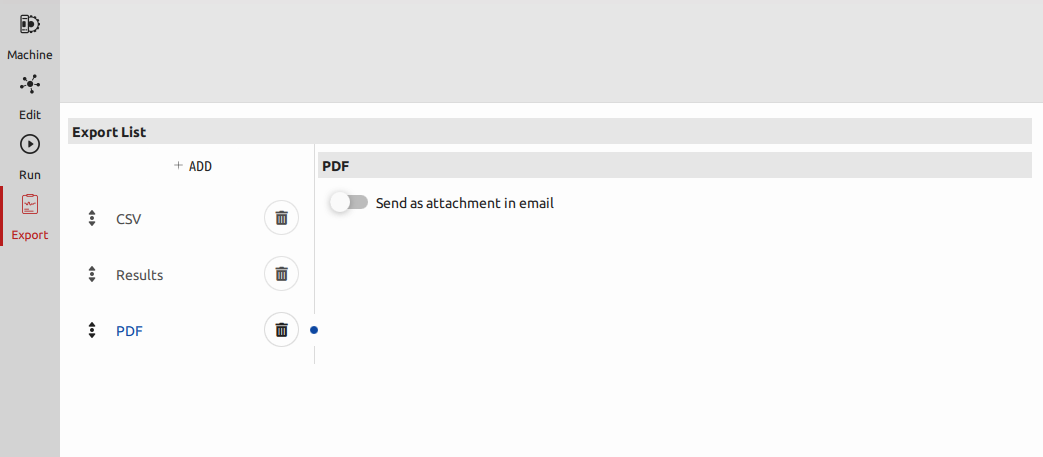Export
The "Export" tab provides several options for exporting test data:
- CSV: Use this option to export the test data in CSV format for further analysis or data manipulation.
- Calculation: This option allows you to perform specific calculations on the test data and export the calculated results.
- PDF: Choose this option to generate a PDF report summarizing the test results and key data points.

Send as Email: Activate this option to send the test data and results as an email attachment to specified recipients.
Data to Export (in CSV mode)
The "Data to Export" section provides users with granular control over the specific test parameters they can include in their exported data. Depending on the test type or configuration, the available parameters may vary, ensuring relevance to the conducted test.
Available Parameters (Based on Test Type):
-
Time: Records the time-related data points during the test.
- Decimal Adjustment: Allows users to specify the precision of time-related values.
- Unit: Choose from standard time units including seconds, minutes, hours, and days for accurate representation.
-
Force: Captures force-related measurements obtained during the test.
- Decimal Adjustment: Configure the precision of force measurements as required.
- Unit: Offers flexibility with units such as Newtons (N), centiNewtons (cN), decanewtons (dan), etc., providing multiple options for precise representation.
-
Stress: Provides data on stress values observed during the test.
- Decimal Adjustment: Adjust the decimal precision to suit analytical needs.
- Unit: Select the appropriate stress units—Pascal, Kpascal, Mpascal, Gpascal, bar, kgf/cm², or kgf/mm²—to align with specific analysis requirements.
-
Cross Head Extension: Measures the extension or displacement of the crosshead during testing.
- Decimal Adjustment: Specify the precision of extension/displacement values.
- Unit: Choose the appropriate unit for extension/displacement representation.
-
Strain: Offers data on the material's strain observed during the test.
- Decimal Adjustment: Adjust the decimal precision as required for accurate strain measurements.
- Unit: Select suitable strain units for representation in the exported data.
Please note that the availability of these parameters for export may vary based on the specific test type or setup. The system will display relevant parameters based on the conducted test to ensure the export data remains pertinent and useful for analysis or documentation purposes.
This comprehensive selection empowers users to tailor their exported data by adjusting decimal precision and choosing units that align with their analysis tools or documentation standards. It ensures flexibility and accuracy in handling diverse testing data for further analysis, manipulation, or report generation.